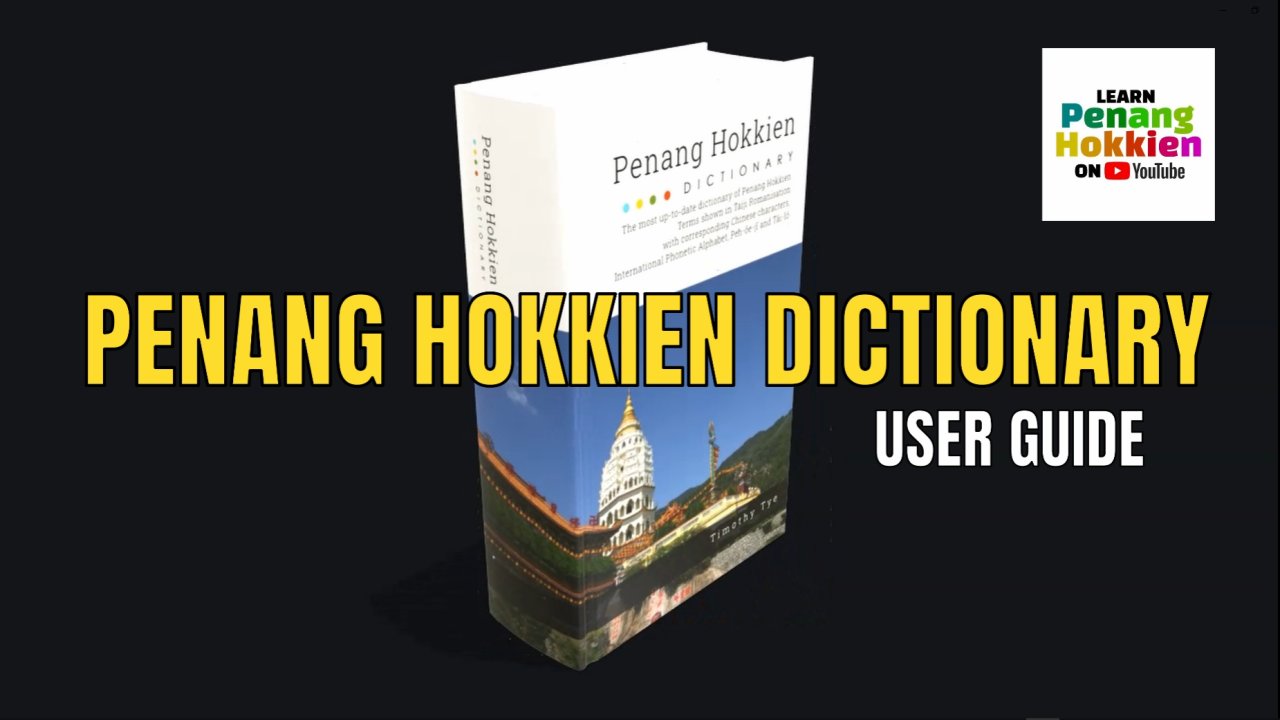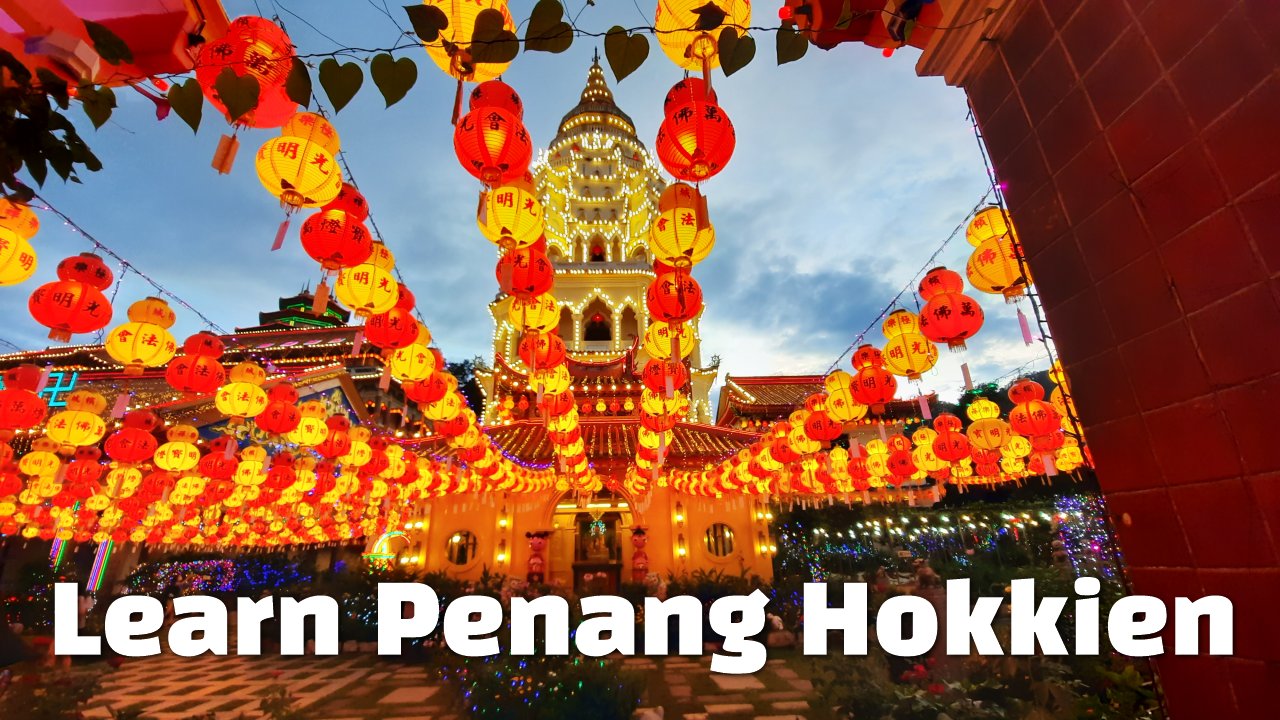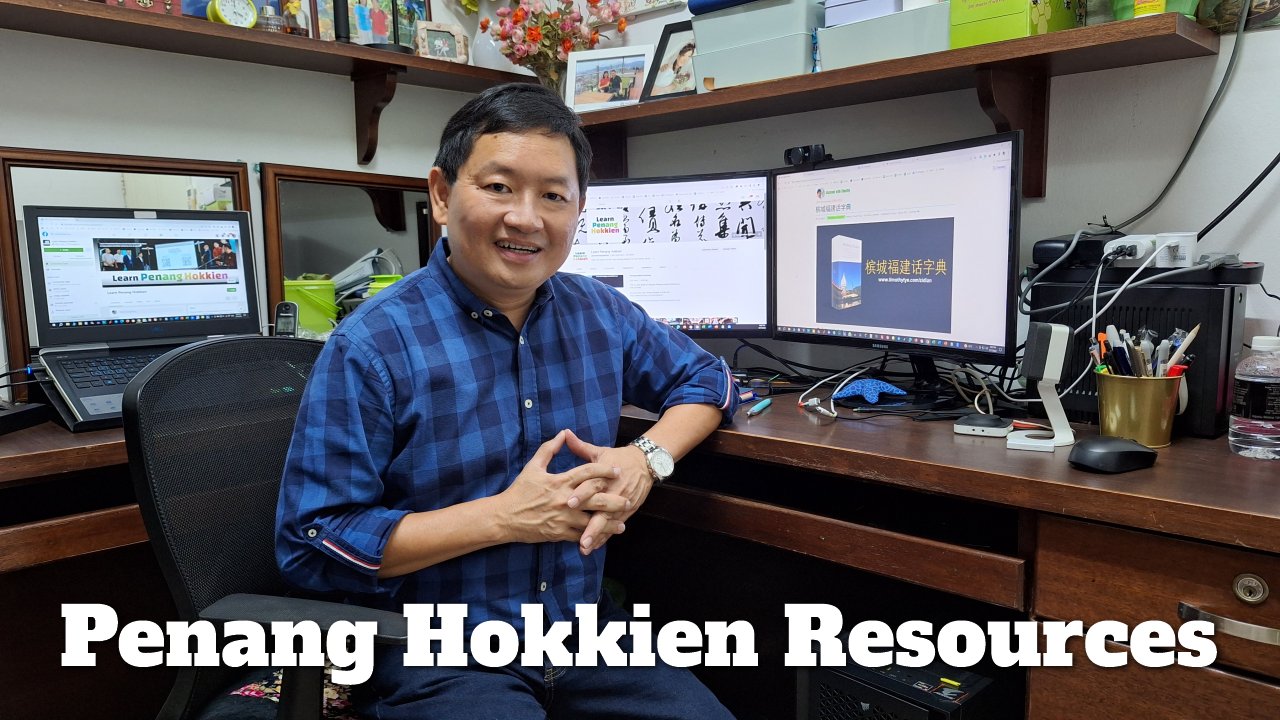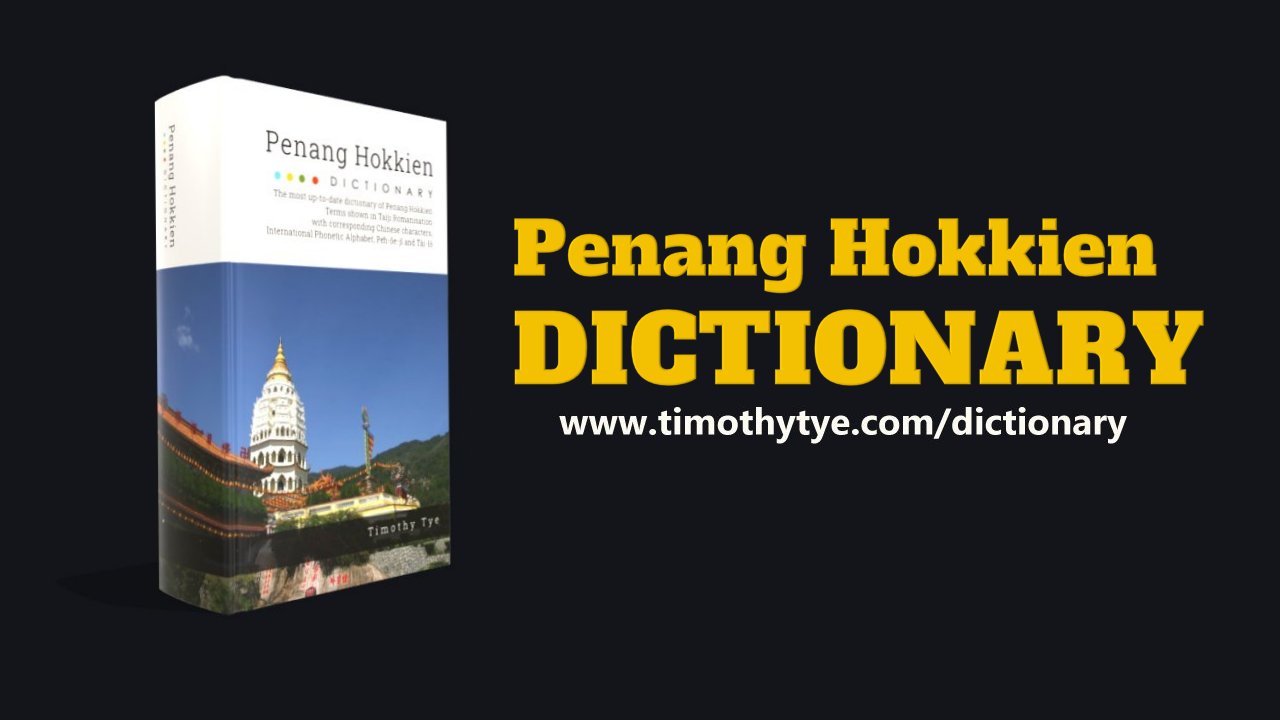
To look up a word in Penang Hokkien, type the corresponding word in English, Chinese or Malay into the input cell (where it says "Type word here"). Then select your input language. For example, if you wish to find "house" in Penang Hokkien, type "house" into the input cell and select "English". You can also type "rumah" and select Bahasa Melayu. Click the "magnifying glass" icon to get your search result.
Refer to the list of abbreviation below.


Penang Hokkien Dictionary
Penang Hokkien Dictionary is an unprecedented guide and invaluable reference to the modern Hokkien dialect as used in Penang and various cities in northern Peninsular Malaysia. This online dictionary renders words in Penang Hokkien using Taiji Romanisation. Entries are listed with definition in English, Malay, Hokkien written with Chinese characters 漢字, Amoy Dialect referencing the 1883 MacGowan Dictionary of Amoy Dialect (also called the Xiamen variant), Taiwanese Hokkien referencing the 2011 Ministry of Education of the Republic of China's Online Minnan Dictionary, and since 2020, Wiktionary for Pinyin, Zhuyin 注音, Wade-Giles, Cantonese (Jyutping and Yale), Hakka (Pha̍k-fa-sṳ; and Guangdong Romanisation), Min Dong/Hock Chew (Bàng-uâ-cê / 平話字/平话字), Teochew (Peng'im 拼音), Middle Chinese and Old Chinese (Baxter-Sagart and Zhengzhang). Words in Penang Hokkien are often discussed among native speakers at Learn Penang Hokkien Facebook Group before they are added. Permission is granted to make print outs of the search results for personal, non-commercial use. To know more about the writing system used in this dictionary for Penang Hokkien, read about Taiji Romanisation.Mobile Friendly Feature
The Penang Hokkien Dictionary is mobile responsive and reformats to fit your smartphone. You can also transfer it from your computer to your smartphone using the following QR code. If you've never scanned a QR code before, first download a QR Code Reader from Google Play or Apple App Store to get started.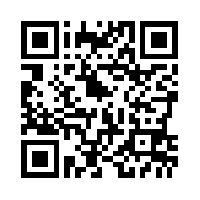
Tiny URL
The abbreviated URL for this page is https://tinyurl.com/hokkiendictionaryAbbreviations
The following abbreviations are used in the dictionary:(?): probable definition
ABB: Abbreviations, short forms
AD: Amoy Dialect (in Missionary Romanisation)
ALF: Alternative form(s)
ANT: Antonym; words with the opposite meaning
BM: Malay/Bahasa Malaysia
CAF: Canonical (main, official) form
CCS: Cheah Cheng Seang, Penang Hokkien (Minnan Dialect)
CDD: Carstairs Douglas Dictionary of the Vernacular or Spoken Language of Amoy (1899)
CF: Cross reference
COL: Colloquial expression
CLR: Colloquial Reading
CN: Hokkien using Chinese characters
CNH: Chinese character, if specific to Hokkien
CR-POJ: Church Romanisation, also known as Pe̍h-ōe-jī and POJ CT: Cantonese
CTJ: Cantonese (Jyutping Romanisation)
CTL: Cantonese loanword
EE: Translation of example sentence in English
EH: Example sentence in Penang Hokkien
EML: English loanword via Malay
ENG: English
ENL: English loanword
ETM: Etymology
FB: Facebook Group input
FIG: Figurative Meaning
HKK: Hakka
HMP: Homophone of
HPY: Hanyu Pinyin
HSC: Hokkien with Simplified Chinese characters
HTC: Hokkien with Traditional Chinese characters
INL: Indian loanword
KHK: Klang Hokkien
LDG: Luc de Gijzel Dictionary of Penang Hokkien, 2nd Edition (2013)
LIT: Literal Meaning
LTR: Literary Reading
MAN: Mandarin, if using different character from Hokkien
MCG: J. MacGowan Dictionary of the Amoy Dialect (1883)
MED: Walter H. Medhurst Dictionary of the Hokkeen Dialect (1832)
MDH: Medan Hokkien
MDL: Mandarin loanword
MDN: Mandarin
MIN: Taiwanese Ministry of Education Min Nan Online Dictionary (2011)
(https://twblg.dict.edu.tw/holodict_new/default.jsp)
MOE: Taiwanese Ministry of Education
MYL: Malay loanword
NB: Nota bene, note well
PHF: Filipino Fookien
PHK: Philippine Hokkien
POJ: Church Romanisation (Pe̍h-ōe-jī)
PTL: Philip T. Lin's book Taiwanese Grammar, A Concise Reference
PY: Pinyin
REF: Reference
SC: Simplified Chinese 华语简体
SHK: Singapore Hokkien
SYN: Synonym; words with the same or similar meaning
TH: Thai
THL: Thai loanword
TC: Traditional Chinese 華語繁体
TR: Taiwanese Romanisation (of Penang Hokkien)
TR-Tai-lo: Taiwanese Romanisation (Tâi-uân Lô-má-jī @ Tâi-lô)
TW: Taiwanese Hokkien (in Taiwanese Romanisation)
TWN: Chinese character unique to Taiwanese Hokkien
US: American English
WIK: Wikipedia reference
WIKT: Wiktionary reference
XDC: https://fangyan.hanwenxue.com/minnanhua/
REF 1: China Heritage Quarterly
REF 2: Singlish Dictionary
REF 3: Ah Kew (https://ahkew.blogkaki.net/viewblog-52527/)
REF 4: https://www.facebook.com/groups/learnpenanghokkien/permalink/414628328688855/
REF 5: https://www.facebook.com/groups/learnpenanghokkien/permalink/415590058592682/
REF 6: https://www.facebook.com/groups/learnpenanghokkien/permalink/985863064898709/
Penang Hokkien Dictionary User Guide
This Penang Hokkien Dictionary uses the Taiji Romanisation System (Taiji) created specially for Penang Hokkien. In this system, the tone of every syllable is represented by a numeral, 1, 2, 3, 33 and 4. These correspond to the four tones of Mandarin, making it easier for many locals to follow intuitively without formal coaching. Morphemes of compound words are toned to output. Taiji does not use any diacritic marks or unique characters, so it can be easily typed on the standard ASCII keyboard of computers, tablets and smartphones.For details of writing Penang Hokkien using the Taiji, go to Learn Penang Hokkien. For a quick lesson, go to Penang Hokkien Made Easy. Listen to the video on Intonation and Tone Sandhi, to help you make sense of the system.
Learn Penang Hokkien Facebook Group
To interact with other Penang Hokkien speakers, or to pick up words and expressions in Penang Hokkien, join the Learn Penang Hokkien Facebook Group.Learn Penang Hokkien on YouTube
Updates on the Penang Hokkien Dictionary
5 July 2023The Penang Hokkien Dictionary was officially launched by the caretaker Chief Minister of Penang YAB Chow Kon Yeow at a ceremony at the Penang Town Hall, alongside the Learn Penang Hokkien YouTube Channel.
4 May 2020
Users may now search the dictionary using Chinese characters, Taiwanese Romanisation (Tâi-lô) and Church Romanisation (POJ). Presently, the dictionary recognizes only Traditional Chinese, as the input so far is mostly Hokkien using Traditional Chinese characters. There is a small amount of Mandarin here, but not much for now.
Acknowledgement and Thanks
This dictionary would not have been possible without the help of numerous native speakers of Penang Hokkien who helped me online and offline, checking on various spelling, contributing input and suggestions. A big thank you to the members of the Learn Penang Hokkien Facebook Group for their assistance in volunteering input that went towards this compilation.I want to express a big thank you to Mr Tee Joo Tatt for his help in creating the Search Box feature for this dictionary, without which searching through the entries would have been more tedious.
Thank you to Ms Adel Boo for help in adding Mandarin in Simplified Chinese to the dictionary. I also want to express my thanks to the many Penang Hokkien book authors who have been supportive of this project, in particular to Mr Tan Choon Hoe, Mr Raymond Kwok and Mr Jonny Chee. A big thank you also to Miss Joanna Phang of Sentral College, for providing a platform to give Penang Hokkien exposure.
If I should miss out of thank you for the contribution you have made in realising this dictionary, I do apologize for having overlooked you, and I thank you the same for your help that goes towards the preservation of Penang Hokkien for the benefit of the future generations of Penang Hokkien speakers.
Learn Penang Hokkien with Memrise
Now you can use the most user-friendly tool on the web to learn Penang Hokkien. It helps you to listen, understand and memorise. Go to Memrise, and learn Penang Hokkien at your own pace.
Latest from Discover with Timothy: Gurney Bay - what to see and do there
About this website

Hello and thanks for reading this page. My name is Timothy and my hobby is in describing places so that I can share the information with the general public. My website has become the go to site for a lot of people including students, teachers, journalists, etc. whenever they seek information on places, particularly those in Malaysia and Singapore. I have been doing this since 5 January 2003, for over twenty years already. You can read about me at Discover Timothy. By now I have compiled information on thousands of places, mostly in Peninsular Malaysia and Singapore, and I continue to add more almost every day. My goal is to describe every street in every town in Malaysia and Singapore.
Robbie's Roadmap
- Episode 1: Robbie's Journey to Financial Freedom
- Episode 2: Lost in America
- Episode 3: The Value of Money
- Episode 4: The Mentor
- Episode 5: The Thing that Makes Money
- Episode 6: The walk with a Billionaire
- Episode 7: The Financial Freedom Awakening
- Episode 8: Meet Mr Washington
- Episode 9: The Pizzeria Incident
Copyright © 2003-2024 Timothy Tye. All Rights Reserved.


 Go Back
Go Back